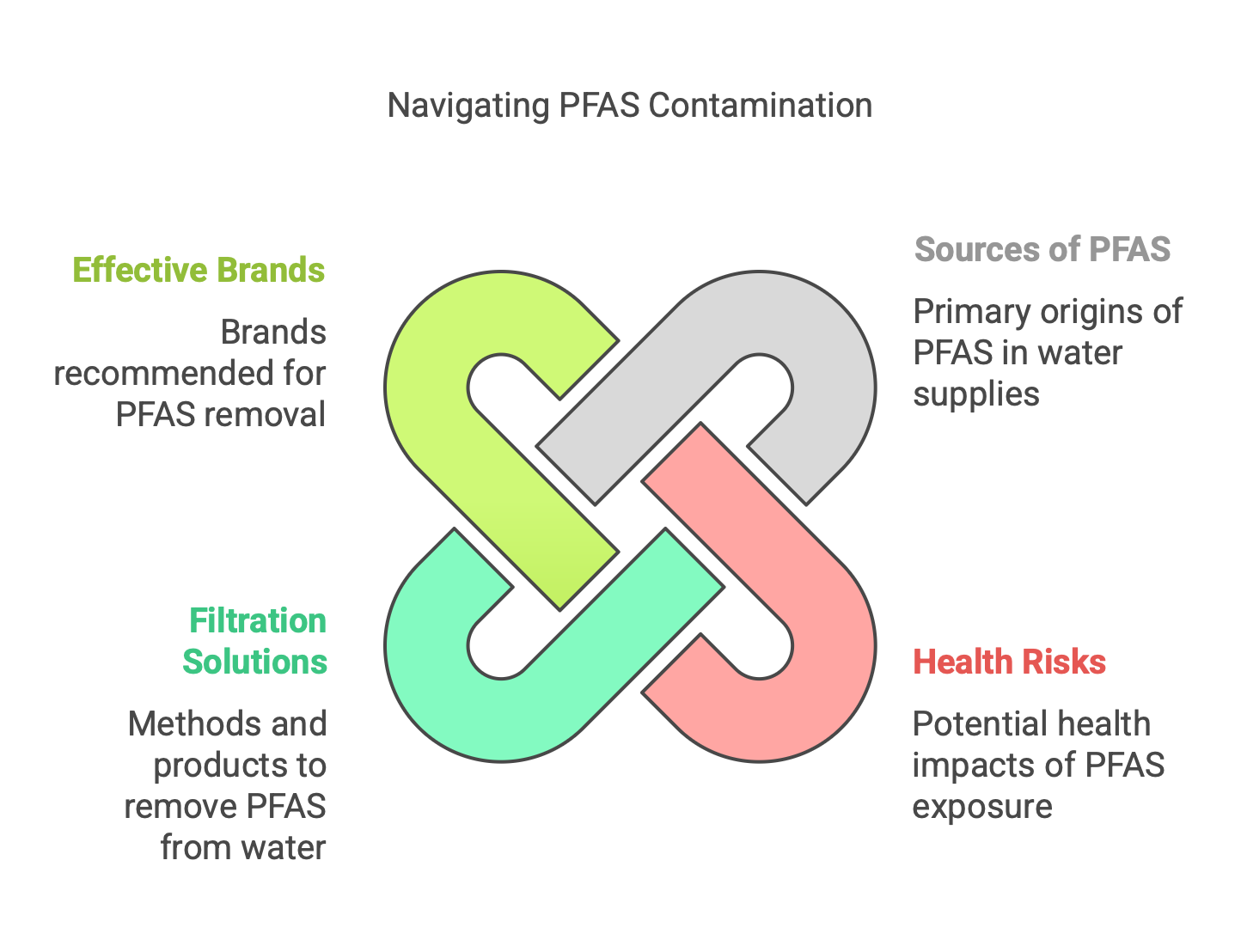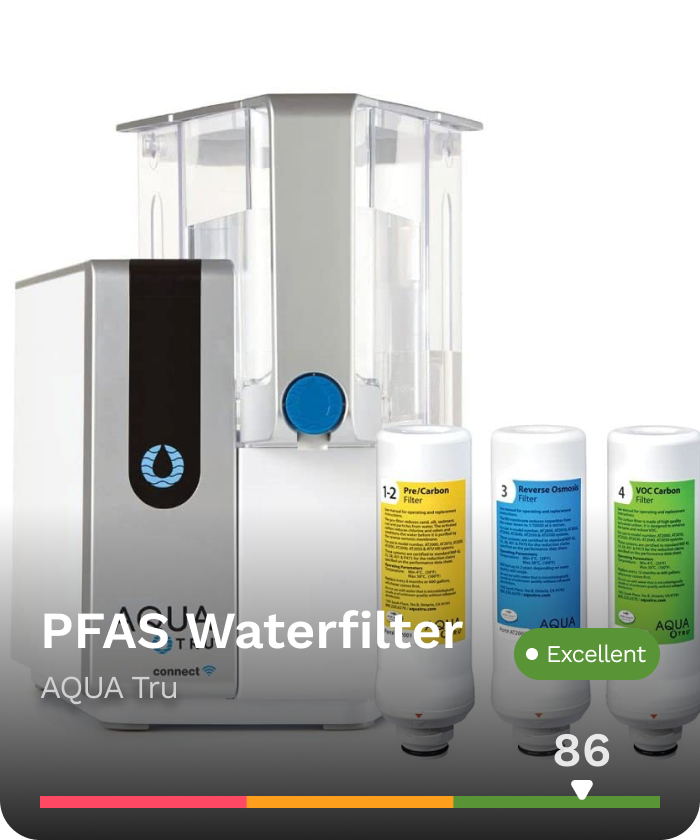TL;DR
PFAS Contamination and Water Filtration Solutions
PFAS, or “forever chemicals,” are widespread in U.S. water supplies, affecting about 200 million Americans. Nearly half of the nation’s tap water contains one or more types of PFAS. Drinking water is a primary source of exposure, making effective filtration crucial. Filters like SpringWell CF1, AquaTru RO, Clearly Filtered Water Pitcher, Big Berkey, and Aquasana AQ-5300 have proven effective in reducing PFAS levels. Consumers should look for filters certified by NSF International or Underwriters Laboratories (UL) for PFAS removal. Though no filter can fully remove PFAS, high-quality systems can significantly reduce exposure.
Health Risks Associated with Prolonged Exposure to PFAS Chemicals
PFAS are a group of chemicals used since the 1940s for their water- and grease-resistant properties. Common examples like PFOA and PFOS are linked to several health risks, including elevated cholesterol, liver issues, reduced vaccine effectiveness, hypertension during pregnancy, low birth weight, and increased cancer risks. These chemicals persist in both the environment and the human body, accumulating over time. As endocrine-disrupting chemicals, PFAS can interfere with hormone functions, leading to various health issues, particularly with continuous exposure from products like nonstick cookware, clothing, and contaminated water or food. Ongoing research continues to explore the extent of their harmful effects.
Primary Sources of PFAS Contamination
PFAS, or “forever chemicals,” are manmade substances that persist in the environment and living organisms due to their strong carbon-fluorine bonds. These chemicals, used in consumer and industrial products, are primarily released from chemical plants, landfills, and treatment facilities. Key contamination sources include firefighting foam (AFFF), industrial production, and manufacturing of PFAS-containing products like carpets and car parts. PFAS are widely present in water, soil, air, and food, and there are over 600 contaminated sites in the U.S. designated for remediation. This widespread use has led to global contamination and ongoing exposure for many.
Criteria for Certified Water Filters to ReducePFAS Levels
PFAS, harmful chemicals found in industrial and consumer products, pose significant health risks, including cancer and developmental issues. To reduce PFAS levels in drinking water, certified point-of-use (POU) water filters are a cost-effective solution. These filters must meet NSF/ANSI standards, including reducing PFOA and PFOS levels to below 70 parts per trillion, as per the EPA’s health advisory. Consumers should look for NSF certifications and verify efficacy through independent testing. Using certified filters is essential to protect against the serious health impacts of PFAS exposure.
Key Differences in Filtration Systems for PFAS Removal
Whole-house filtration systems filter all water in the home but are generally less efficient at removing PFAS due to larger filter micron sizes and may require professional installation. Reverse osmosis (RO) systems, installed under the kitchen sink, provide superior PFAS removal for drinking and cooking water but have limited output and generate wastewater. The choice between these systems depends on water quality needs, household size, budget, and whether the property is owned or rented. RO systems are ideal for drinking water, while whole-house systems cover all water uses.
PFAS Chemicals Interaction with Ecosystems
PFAS, a group of man-made chemicals, are used in everyday products and industrial applications, earning the nickname “forever chemicals” due to their slow degradation. They enter the environment through production waste, landfills, septic systems, and runoff from airports and agricultural fields. PFAS contaminate soil, water, and air, affecting aquatic ecosystems and wildlife. The U.S. EPA is working on water quality criteria for PFAS, but these are not legally binding. PFAS persist in soils, impacting both terrestrial and aquatic environments, and may be taken up by plants.
PFAS Removal Technologies
Several technologies are used to remove PFAS from drinking water, each employing different mechanisms:
- Granular Activated Carbon (GAC): Adsorbs PFAS onto its porous surface, effectively reducing PFAS concentrations.
- Powdered Activated Carbon (PAC): Adds powdered carbon to water, binding PFAS molecules for removal.
- Ion Exchange Resins: Small beads attract and bind PFAS molecules, offering effective removal.
- Membrane Separation: Methods like nanofiltration and reverse osmosis use small pores to filter out PFAS molecules, providing thorough purification.
Introduction
PFAS, also known as “forever chemicals,” are increasingly found in water supplies across the United States, posing a significant health risk to an estimated 200 million Americans[1][2]. These toxic substances contaminate the drinking water and groundwater of more than 7,000 communities[2]. According to the U.S. Geological Survey, almost half of the nation’s tap water has been contaminated by one or more of the 32 individual PFAS for which the agency tested[3]. One of the primary sources of PFAS exposure is drinking water, which underscores the urgent need for effective filtration solutions[3]. Despite the widespread presence of PFAS in water supplies, there are steps that individuals can take to protect themselves and their families, such as using water filters specifically designed to target these chemicals[2][3]. However, the market for water filtration systems is saturated with various options, making it difficult to discern which filters are genuinely effective at removing PFAS[1][4]. Several water filter brands have been identified as effective in eliminating some PFAS from drinking water. The Environmental Working Group (EWG) has recommended specific filters based on their extensive testing and experience with different brands[2]. Among the most effective filters are the SpringWell CF1 whole-house filter, which utilizes a 4-stage filtration process to remove over 99.5% of PFAS, and the AquaTru RO System, a countertop system with NSF certifications[1][4][5]. Other notable options include the Clearly Filtered Water Filter Pitcher, the Big Berkey portable filter, and the Aquasana AQ-5300 3-stage under-sink filter[4][5][6]. Given the complexity and severity of PFAS contamination, it is essential for consumers to choose filters that have been certified by reputable organizations like NSF International or Underwriters Laboratories (UL), specifically for PFAS removal[5]. While no filter can completely eliminate all traces of these persistent chemicals, using a high-quality filtration system can significantly reduce exposure to PFAS in drinking water[5].
ALVA Favourites
When you make a purchase through retailer links on our site, we may earn commission through affiliate programs. All affiliate fees ALVA receives support our mission. Learn more here
Are your products safe?
Scan your products now with the ALVA app to get a personalised risk analysis.

Best water filtration systems for toxic PFAS forever chemical filtration
Health Risks Associated with Prolonged Exposure to PFAS Chemicals
PFAS (per- and polyfluoroalkyl substances) are a group of manufactured chemicals
that have been used in various industries and consumer products since the 1940s
due to their beneficial properties[7]. Some of the most widely studied PFAS include
perfluorooctanoic acid (PFOA) and perfluorooctane sulfonate (PFOS), which have
been largely replaced in the United States by other PFAS compounds in recent
years[7]. A notable concern regarding PFAS is their persistence in the environment
and the human body, where they break down very slowly and can accumulate over
time[7].
Exposure to PFAS has been linked to a range of health effects. Epidemiological evi-
dence suggests associations between increased levels of specific PFAS in the blood
and several adverse health outcomes. These include elevated cholesterol levels,
reduced antibody response to vaccines, altered liver enzymes, pregnancy-induced
hypertension and preeclampsia, small decreases in birth weight, and increased risks
of kidney and testicular cancer[8][10]. The risk of these health effects can vary based
on several factors, including the dose, frequency, route, and duration of exposure, as
well as individual susceptibility and other health determinants[8][11].
PFAS are endocrine-disrupting chemicals (EDCs) that can interfere with hormone
functions in the body. Continuous exposure to PFAS through everyday items such as
clothes, nonstick cookware, and upholstery, as well as through contaminated food,
water, and air, can lead to various health issues over time[9]. Research is ongoing to
better understand the specific mechanisms by which PFAS exert their toxic effects,
but the consistent finding across studies is their association with multiple negative
health outcomes[9][10].
Primary Sources of PFAS Contamination
PFAS, or per-and polyfluoroalkyl substances, are manmade chemicals that have
been used extensively in both consumer and industrial products due to their unique
properties[12]. These chemicals, often referred to as “forever chemicals,” have a
strong carbon-fluorine bond that prevents them from breaking down easily, allowing
them to accumulate in the environment and in living organisms over time[12][14].
Primary sources of PFAS contamination include chemical plants and other industrial
facilities, landfills, and treatment plants[12]. Additionally, there are three significant
sources: the use of aqueous film-forming foam (AFFF) at airports, industrial sites,
and firefighting training centers; industrial PFAS production by major industries; and
manufacturing sites of PFAS-containing products, such as carpets and car parts[15].
PFAS are also widely found in the environment due to their extensive use and
persistence. They can be present in water, soil, air, and food, as well as in materials
within homes and workplaces[14]. There are more than 600 contaminated sites
across the United States, some of which are designated as Superfund sites requiring
remediation or treatment[15]. The widespread use and release of PFAS have led
to global contamination, causing substantial background exposure that affects all
Americans[15].
Criteria for Certified Water Filters to
Reduce PFAS Levels
Per- and polyfluoroalkyl substances (PFAS) are a group of chemicals widely used in
industrial and consumer products, known to cause various health issues. Reducing
PFAS levels in drinking water is essential to limit exposure to these harmful chem-
icals. Certified water filters are an effective solution for this purpose. Point-of-use
(POU) filters, which treat water at a single faucet, are a relatively inexpensive option
for reducing PFAS in homes[19].
To ensure effectiveness, water filters must meet specific certification criteria. The
NSF joint committee recently updated the American National Standards for resi-
dential drinking water treatment and reverse osmosis (RO) devices to include test
methods and other requirements for reducing perfluorooctanoic acid (PFOA) and
perfluorooctane sulfonate (PFOS), two of the most common PFAS contaminants.
Certified devices must reduce PFOA and PFOS concentrations in water to below
the 70 parts per trillion (ppt) health advisory level set by the U.S. Environmental
Protection Agency (EPA). Additionally, these devices must comply with the material
and physical requirements of NSF/ANSI 53: Drinking Water Treatment Units – Health
Effects or NSF/ANSI 58: Reverse Osmosis Drinking Water Treatment Systems[20].
Consumers should verify these certifications by checking for NSF/ANSI standards
on the product labels or by contacting their state environmental protection agency or
health department for recommendations[19]. Independent product testing is another
reliable way to ensure a household filter’s efficacy in PFAS removal[22].
Exposure to unsafe levels of PFAS in drinking water can result in significant health
effects, including developmental issues during pregnancy, cancer, liver damage,
immune system impacts, and thyroid problems[21]. Therefore, choosing certified
filters is crucial to safeguard against these potential health risks.
Key Differences in Filtration Systems for
PFAS Removal
When it comes to filtering out PFAS (per- and polyfluoroalkyl substances), under-
standing the key differences between whole-house filtration systems and reverse
osmosis (RO) units is crucial for making an informed choice.
Whole-house water filtration systems are installed at the main water line entry point,
ensuring that all the water used in a home, whether for drinking, showering, or cook-
ing, is filtered[24][25]. These systems use a collective set of filters with micron sizes
ranging from 10 to 30 microns, which allows for a higher flow rate[25]. Whole-house
filters can remove a variety of contaminants, including some PFAS, but they are
generally less thorough compared to RO systems due to the larger micron size oftheir filters[25][26]. Additionally, the installation of these systems can be complex and
may require professional plumbing, making them less ideal for rental properties[24].
On the other hand, reverse osmosis systems are point-of-use (POU) systems
typically installed under the kitchen sink, targeting water used for drinking and
cooking[25][26]. RO systems utilize membrane separation technology to remove
a wide range of contaminants, including PFAS, with much higher efficiency than
whole-house systems[23][26]. These systems are designed to provide highly purified
water, enhancing both taste and safety[27]. However, they have a limited output and
generate a significant amount of wastewater in the filtration process[26].
When deciding between these two options for PFAS removal, one should consider
factors such as specific water quality needs, the size of the household, budget
constraints, and whether the property is owned or rented[26]. While whole-house
systems offer comprehensive filtration for all water usage in the home, RO systems
provide superior purification for drinking and cooking water[26].
PFAS Chemicals Interaction with Ecosystems
Per- and polyfluoroalkyl substances (PFAS) are a large class of man-made chemicals
that have been used in a variety of industries since the 1940s. They are prevalent
in everyday items such as food packaging, non-stick products, stain repellents, and
waterproof clothing, as well as in industrial applications and firefighting[16]. PFAS are
known for their persistence in the environment and the human body, earning them
the moniker “forever chemicals” due to their slow degradation rate[29].
PFAS can enter the environment through multiple pathways, including production and
waste streams, septic systems, landfills, airport runoffs, and agricultural fields. Once
released, these chemicals can contaminate soil, water, and air, eventually reaching
aquatic ecosystems[18]. PFAS can be transported through watersheds and aquifers,
and they integrate into food webs, affecting fish and wildlife at various biological
levels[17].
One significant concern is the impact of PFAS on water quality. These chemicals have
been detected in surface water and groundwater systems, leading to contamination
of drinking water supplies[29][32]. As a result, the U.S. Environmental Protection
Agency (EPA) is developing national recommended water quality criteria for PFAS
to protect human health, though these criteria are not legally binding[28][30].
In terms of soil, PFAS contamination is widespread. Studies have shown that even
soils with no known sources of PFAS contamination contain background levels of
these substances, highlighting their pervasive nature[33]. PFAS bind to soil particles,
which can lead to long-term environmental persistence and potential uptake by
plants, posing a risk to both terrestrial and aquatic ecosystems[33].
Mechanisms of Different Filtration Technologies
for PFAS Removal
Per- and polyfluoroalkyl substances (PFAS) are a group of man-made chemicals
that persist in the environment and can accumulate in human and animal bodies,
posing significant health risks[34][37]. Various technologies have been developed to
address the challenge of removing these persistent substances from drinking water,
each employing different mechanisms to achieve this goal.
One commonly used method is Granular Activated Carbon (GAC) filtration. GAC
filters remove PFAS primarily through adsorption, a process where the porous
surface of the carbon attracts and traps PFAS molecules as water passes through
the filter[35]. This method has been shown to be effective at removing a wide range of
PFAS compounds, significantly reducing their concentration in treated water[35][39].
Another variation of this method is the use of Powdered Activated Carbon (PAC),
where powdered carbon is added directly to the water, allowing PFAS molecules to
stick to the carbon particles as they are filtered out[39].
Ion exchange resins offer another effective solution for PFAS removal. These resins
consist of small beads made of hydrocarbons that act like magnets, attracting and
binding to PFAS molecules as water flows over them[39]. This method is particularly
effective due to the strong affinity between the resins and the PFAS compounds.
Membrane separation technologies, such as nanofiltration and reverse osmosis, also
play a critical role in PFAS removal. These methods involve pushing water through
a membrane with small pores that act as a barrier, preventing PFAS and other
contaminants from passing through[39]. High-pressure membranes are effective at
removing a broad spectrum of PFAS molecules, providing another layer of protection
for drinking water supplies.
References
[1]: The 5 Best PFAS Water Filters to Remove Forever Chemicals
[2]: Getting ‘forever chemicals’ out of drinking water: EWG’s guide to PFAS …
[3]: EWG tests find four water filters that effectively remove ‘forever …
[4]: 6 Best Water Filters for PFAs “Forever Chemicals” of 2025
[5]: Best Water Filter For PFAS: Top 7 Expert Picks 2024 – Quality Water Lab
[6]: 7 Best Water Filters For PFAS & PFOA + Filter Buying Guide
[7]: Our Current Understanding of the Human Health and Environmental Risks …
[8]: How PFAS Impacts Your Health | PFAS and Your Health | ATSDR
[9]: What Are Forever Chemicals (PFAS)? – Cleveland Clinic Health Essentials
[10]: Health Effects: PFAS Information for Clinicians – 2024
[11]: 3 Potential Health Effects of PFAS – The National Academies Press
[12]: Where does PFAS contamination come from? – EHN
[13]: PFAS Explained | US EPA – U.S. Environmental Protection Agency
[14]: Our Current Understanding of the Human Health and Environmental Risks …
[15]: Exposure – STEEP – University of Rhode Island
[16]: Understanding PFAS in the Environment | US EPA
[17]: PFAS Transport, Exposure, and Effects | U.S. Geological Survey – USGS.gov
[18]: We Traced the Forever Chemicals Getting Into Ocean Ecosystems
[19]: Identifying Drinking Water Filters Certified to Reduce PFAS
[20]: PFOA/PFOS Reduction Claims Requirements Added to NSF Standards… | NSF
[21]: PFAS in Drinking Water – NSF
[22]: List of household filters approved for certain PFAS removal
[23]: Water Filter Vs Reverse Osmosis: Which is Better?
[24]: Whole House Water Filtration Systems vs. Reverse Osmosis Systems
[25]: Reverse Osmosis Vs. Whole House Water Filter – APEC WATER
[26]: Reverse Osmosis Systems vs Whole House Water Systems
[27]: Whole House Water Filtration vs. RO System | Express Water
[28]: Human Health Water Quality Criteria for PFAS | US EPA
[29]: PFAS—“Forever Chemicals”—May Be the Biggest Water Problem Since Lead
[30]: EPA Releases Draft Health-Based Recommendations for PFAS Levels in …
[31]: Water Sanitation and Health – World Health Organization (WHO)
[32]: EPA: PFAS forever chemicals found in drinking water systems for 70M
[33]: PFAS, Part 2: How Do PFAS Interact With Soil … – A Nourishing Harvest
[34]: Reducing PFAS in Drinking Water with Treatment Technologies
[35]: What’s the effect of Granulated Activated carbon filter against PFAS in …
[36]: A Critical Review on PFAS Removal from Water: Removal Mechanism and …
[37]: PFAS removal from your water – Woder
[38]: Worried about PFAS in your drinking water? Here’s what the evidence …
[39]: Treating PFAS in Drinking Water | US EPA
Are your products save?
Download ALVA to check if the products you use regularly are free from dangerous chemicals.

